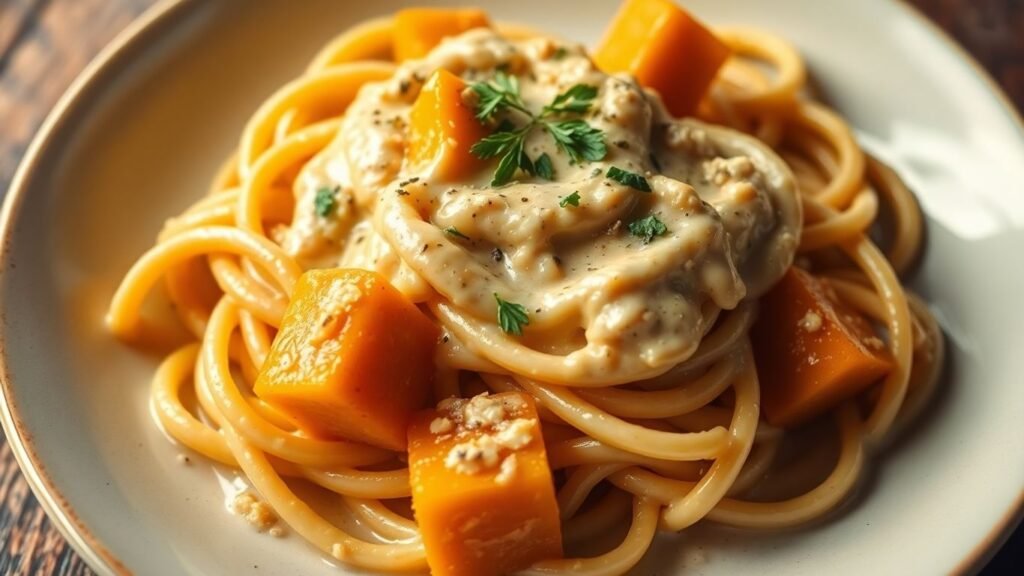So, you’re looking to make some butternut squash pasta, huh? It sounds fancy, but honestly, it’s not that hard to pull off. I’ve been messing around with fall recipes, and this one, with a wine-infused chestnut sauce, has really become a favorite. It’s got that perfect mix of sweet and savory, and it feels really special without being too complicated. Let’s get this butternut-pasta dish on your table.
Key Takeaways
- Start with a good butternut squash, peel it, seed it, and cut it into small, even pieces for cooking.
- Cook the pasta until it’s just right, not too soft, and save some of that starchy water – it’s like magic for the sauce.
- The sauce gets its depth from chestnuts and a splash of white wine, which you’ll reduce down.
- Fresh sage and a bit of pancetta add a really nice savory touch, and brown butter gives it a nutty flavor.
- Finishing with cheese and a squeeze of lemon brightens everything up for a balanced butternut-pasta dish.
Crafting The Butternut Squash Pasta Base

Selecting The Perfect Butternut Squash
When you’re building the foundation for this elegant pasta dish, the butternut squash is your star. Look for a squash that feels heavy for its size, which usually means it’s packed with moisture and flavor. A smooth, unblemished skin is also a good sign. The best squash will have a nice, even tan color. Avoid any with soft spots or dark patches. A good rule of thumb is to pick one that’s on the larger side, as this often translates to a sweeter, more developed flavor. You’re aiming for that vibrant orange flesh inside, which promises a beautiful color and a naturally sweet taste for your sauce.
Preparing Squash For Creamy Perfection
Getting the squash ready is pretty straightforward, but doing it right makes all the difference. First, you’ll want to peel it. A sturdy vegetable peeler works well, but be careful, as the skin can be a bit tough. Once peeled, slice it in half lengthwise, scoop out the seeds and stringy bits, and then cut the flesh into uniform cubes, about half an inch is good. This even sizing helps the squash cook evenly. You can roast it, but for this pasta, we’re going to sauté it to get those lovely caramelized edges.
Achieving Al Dente Pasta
Cooking the pasta is a bit of an art. You want it al dente, which means it still has a slight bite to it. The best way to achieve this is to cook it in well-salted water, just shy of the package directions. Seriously, pull it out a minute or two early. Why? Because it’s going to finish cooking in the sauce with the squash. This way, it absorbs all those wonderful flavors without turning mushy. Remember to save some of that starchy pasta water before you drain it – it’s liquid gold for bringing the sauce together later on.
The Wine-Infused Chestnut Sauce
This sauce is where the real magic happens, transforming simple ingredients into something truly special. We’re building layers of flavor, starting with the rich, earthy notes of chestnuts and the subtle complexity that wine brings to the table.
The Role Of Wine In The Sauce
Wine isn’t just for drinking alongside your pasta; it’s a key player in creating a vibrant sauce. When you deglaze the pan with wine, you’re lifting all those tasty browned bits from the bottom, incorporating them into the liquid. This process adds a depth of flavor that you just can’t get otherwise. A dry white wine, like a Pinot Grigio or Sauvignon Blanc, works wonderfully here, offering a bit of acidity to cut through the richness of the other ingredients. It mellows as it cooks, leaving behind a pleasant, slightly fruity undertone.
Incorporating Chestnuts For Depth
Chestnuts bring a unique sweetness and a wonderfully smooth texture to this sauce. They have a natural nuttiness that pairs perfectly with the squash. To get the most out of them, we’ll sauté them briefly to bring out their flavor before adding them to the sauce. You can use pre-cooked and peeled chestnuts, which are readily available in most grocery stores. Simmering them in milk for a bit can also help create a smoother puree if you’re going that route, making chestnut puree is quite simple.
Achieving A Silky Sauce Consistency
Getting that luxurious, silky texture is all about technique. After deglazing with wine and adding your cream, let the sauce simmer gently. This allows it to thicken naturally. A little bit of pasta water, that starchy liquid left behind after cooking your pasta, is your secret weapon for emulsifying the sauce. It helps bind the fat and liquid together, creating a smooth, creamy coating that clings beautifully to the pasta. Don’t be afraid to add a splash or two until you reach that perfect consistency.
The goal is a sauce that coats the pasta without being too heavy, a delicate balance that makes each bite a delight.
Here’s a quick rundown of how the sauce comes together:
- Sauté aromatics (like shallots) and chestnuts in the pan.
- Deglaze with white wine, letting it reduce.
- Add cream and simmer until slightly thickened.
- Stir in a splash of pasta water to emulsify.
- Season with salt and pepper to taste.
Elevating Your Butternut Pasta

The Magic Of Sage And Pancetta
Adding a few key ingredients can really take your butternut squash pasta from good to absolutely fantastic. Think about crisping up some pancetta until it’s golden and a little chewy. The salty, fatty bits that render out are pure gold. Then, toss in some fresh sage leaves with the pancetta in its last minute of cooking. They get wonderfully crispy and add this amazing aromatic quality. It’s a simple step, but it makes a huge difference.
Nutty Brown Butter Notes
Brown butter is a game-changer for pasta dishes, especially with squash. When you melt butter and let it cook a bit longer, it turns a lovely nutty brown color and develops this incredible aroma. It adds a depth of flavor that plain melted butter just can’t match. This subtle nuttiness complements the sweetness of the butternut squash perfectly.
The Creamy Finish With Cheese
To bring it all together, a good grating of Parmesan cheese is a must. Stir it in off the heat, letting the residual warmth melt the cheese into the sauce. This not only adds a salty, savory kick but also helps to create a wonderfully creamy texture. If the sauce seems a little too thick, a splash of that starchy pasta water you saved earlier will loosen it up beautifully, making everything cling to the pasta just right.
Seasonal Pairings For Butternut Pasta
When the air gets crisp and the leaves start to turn, our thoughts naturally drift to comforting, harvest-inspired meals. Butternut squash pasta, with its inherent sweetness and creamy texture, is a perfect canvas for the flavors of autumn. It’s not just about the squash itself, though; the supporting cast of ingredients can really make this dish sing. Think about how certain herbs and spices just feel like fall – that’s what we’re aiming for here.
Chestnuts and New Wine Traditions
Chestnuts bring a wonderful, earthy depth that complements the sweetness of butternut squash beautifully. They have a slightly nutty, almost sweet flavor profile that gets richer when cooked. Pairing this pasta with a wine that has seen some time with chestnuts, or even incorporating chestnuts directly into the sauce, creates a really cohesive dish. It’s a nod to old-world traditions where these ingredients often found their way onto the same plate. Consider a wine that’s been aged in chestnut barrels, if you can find one, or simply a robust red that can stand up to the earthy notes.
Autumnal Herb Pairings
Herbs are key to bringing out the best in butternut squash. Sage, of course, is a classic partner, its slightly peppery, earthy notes cutting through the richness. But don’t stop there! Thyme offers a subtle, woodsy aroma that’s perfect for fall. Rosemary, used sparingly, can add a pine-like fragrance that’s invigorating. Even a touch of marjoram can provide a gentle, sweet, almost floral note. These herbs aren’t just for garnish; they infuse the sauce and the squash with layers of flavor.
Here’s a quick guide to some great herb pairings:
- Sage: Classic, peppery, and earthy. Works wonders with brown butter.
- Thyme: Subtle, woodsy, and slightly floral. Great in cream sauces.
- Rosemary: Piney and strong. Use a light hand, perhaps minced finely.
- Marjoram: Mildly sweet and aromatic. A gentler alternative to oregano.
Complementary Fall Flavors
Beyond herbs, other fall staples can really round out the dish. Pancetta or crispy bacon adds a salty, savory crunch that contrasts nicely with the smooth pasta and squash. Toasted nuts, like walnuts or pecans, provide texture and a deeper nutty flavor. A touch of lemon zest can brighten everything up, preventing the dish from feeling too heavy. And for a bit of warmth, a pinch of nutmeg or cinnamon in the sauce can be surprisingly delightful, echoing the spices often found in baked goods this time of year.
When building your perfect fall pasta, think about balancing the sweet squash with savory elements, adding textural contrast, and incorporating aromatic herbs. It’s about creating a dish that feels both comforting and complex, a true taste of the season.
Mastering The Butternut Pasta Technique

Getting this pasta just right is all about a few key steps. It’s not complicated, but paying attention to the details makes a big difference in the final dish. Let’s break down how to really nail it.
Sautéing Squash to Golden Brown
First things first, you want to get a good sear on your butternut squash. Heat a good amount of olive oil in a skillet over medium-high heat until it’s shimmering. Add your cubed squash, making sure not to crowd the pan – give it some space! Season it well with salt and pepper. Let it cook undisturbed for a few minutes until it develops a nice, deep brown crust. Then, stir and repeat. This caramelization is where a lot of that sweet, nutty flavor comes from. You’re aiming for tender squash with those lovely browned edges. It should take about 5-7 minutes of active cooking time.
Deglazing The Pan With Wine
Once the squash is beautifully browned and tender, it’s time to add your aromatics like shallots and sage, cooking them briefly until fragrant. Then comes the wine. Pour in your chosen wine and scrape up all those browned bits stuck to the bottom of the pan. This is called deglazing, and it’s a simple way to add a huge amount of flavor to your sauce. Let the wine bubble and reduce by about half, concentrating its taste and cooking off the harsh alcohol. This step really builds the foundation for that wine-infused sauce we’re going for.
Emulsifying The Sauce With Pasta Water
This is perhaps the most important technique for a truly silky sauce. As your pasta cooks, reserve about a cup or two of that starchy cooking water. When you add the cooked pasta to your skillet with the squash and wine reduction, also add a splash of this reserved pasta water. Toss everything vigorously over medium-high heat. The starch in the water acts as an emulsifier, binding the fat from the butter and oil with the liquid, creating a creamy, cohesive sauce that clings beautifully to the pasta. Keep adding splashes of pasta water as needed to achieve your desired sauce consistency. The goal is a glossy, well-combined sauce, not a watery one.
Here’s a quick rundown of the process:
- Cook pasta in just enough water to cover it, reserving the starchy liquid.
- Add cooked pasta and a splash of pasta water to the skillet with the squash mixture.
- Toss vigorously over heat, adding more pasta water as needed, until the sauce emulsifies and coats the pasta.
- Stir in cheese off the heat for the final creamy finish.
This method ensures every strand of pasta is coated in that delicious, complex sauce, making for a truly satisfying meal. It’s a technique that works wonders for many pasta dishes, not just this one. You can find more tips on making great pasta at Marcela’s spaghetti.
Remember, the starchy pasta water is your secret weapon for creating a restaurant-quality sauce at home. Don’t skip this step!
A Symphony Of Flavors In Butternut Pasta

This dish is all about bringing together different tastes and textures to create something truly special. It’s not just about the squash; it’s how everything plays together.
Balancing Sweet Squash With Savory Notes
The natural sweetness of the butternut squash is the star, but it needs friends to make it shine. We get a nice savory depth from ingredients like shallots and the nutty brown butter. Then, there’s the umami kick from the Parmigiano-Reggiano cheese, which really rounds out the flavor profile. It’s this contrast that makes each bite interesting.
The Tangy Brightness Of Lemon
A little squeeze of lemon juice at the end is a game-changer. It cuts through the richness of the sauce and the sweetness of the squash, adding a bright, zesty note that wakes everything up. It’s like a little burst of sunshine in the bowl.
Achieving A Harmonious Butternut Pasta
Getting the balance right is key. Here’s a quick rundown of how we bring it all together:
- Sauté the squash: Get it nicely browned for that caramelized flavor. This step is really important for developing the squash’s taste. See how nice
- Build the sauce: Cook down the shallots and sage in butter until fragrant. Deglazing with a bit of wine (if you’re using it) adds another layer.
- Combine and emulsify: Toss the pasta with the squash mixture and a splash of that starchy pasta water. Keep stirring over heat until the sauce coats the pasta beautifully. This is where the magic happens, turning simple ingredients into a cohesive dish.
- Finish with cheese: Stir in the Parmesan off the heat. This makes the sauce creamy and adds that salty, savory finish.
The goal is a dish where no single flavor overpowers the others. It should feel comforting yet bright, rich yet balanced. It’s a testament to how simple, seasonal ingredients can create something truly memorable when prepared with care.
Enjoy Your Cozy Creation
So there you have it – a really nice pasta dish that tastes like autumn in a bowl. It might take a little bit of effort, but the creamy sauce, the sweet squash, and that hint of wine and chestnut really make it worth it. It’s the kind of meal that feels special without being too fussy. Perfect for a chilly evening or when you just want something comforting. Give it a try, and I bet you’ll love it as much as I do.
Frequently Asked Questions
What kind of squash is best for this pasta dish?
Butternut squash is the star here! It has a lovely sweet and nutty taste that works perfectly in pasta dishes. Look for one that feels heavy for its size, which usually means it’s full of flavor.
How do I make the squash super creamy?
After you cut the squash into small pieces, cook it until it’s really soft. Then, you can mash it up or blend it to make it smooth and creamy. Adding a little bit of the pasta’s cooking water helps make the sauce extra smooth too.
What does ‘al dente’ pasta mean?
‘Al dente’ is an Italian phrase that means the pasta is cooked just right – it should still have a slight bite to it, not be mushy. You usually cook it a minute or two less than the package says.
Why is wine used in the sauce?
Wine adds a special flavor to the sauce. It helps to bring out the tastes of the other ingredients and adds a little tanginess that balances the sweetness of the squash. It also helps create a richer sauce.
Can I use something other than chestnuts?
While chestnuts give the sauce a unique, slightly sweet and nutty flavor, you could try other nuts like walnuts or pecans if chestnuts aren’t available. Just make sure they are finely chopped or even ground.
What makes the sauce silky?
A silky sauce comes from cooking it slowly and adding a bit of liquid, like cream or some of the starchy water from cooking the pasta. Stirring in cheese at the end also helps make the sauce smooth and rich.


